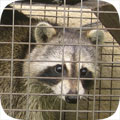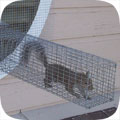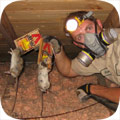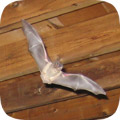- youngstown@wildlifeanimalcontrol.com
Call 24/7 for a free quote:
440-527-6300
Youngstown Wildlife Animal Control
Professional Wildlife Removal Company Servicing Youngstown, OH
If you have a problem with wildlife in your Youngstown home, your best option is to hire a company that specializes in Ohio wildlife removal only. This is a specialty business, and regular pest control companies do not use the proper techniques to solve animal problems. I have spent many years reviewing Ohio and Youngstown, and I recommend the following:
Wildlife & Environmental Solutions
Cell Phone: 440-527-6300
NOTE: If you have a dog or cat problem, call Mahoning County Animal Services: (330) 549-1111

Wildlife & Environmental Solutions specializes primarily in removing animals from attics of homes and buildings - this includes squirrels in attics, raccoons, and rats or mice in homes. Ohio also has a documented problem with
bats in buildings, and Wildlife & Environmental Solutions is specially trained in bat removal. They also perform general wildlife trapping services, such as the capture and removal of skunks or opossums on the
property. Call 440-527-6300 to discuss your critter problem and schedule a same-day or next-day appointment. Click here to learn more about what prices we charge in 2020.
When hiring a company to solve your wild animal problem, you want these features:
- Specializes in wildlife removal, not pest control
- Fully Ohio and Mahoning County licensed and insured
- Works 7 days per week (critters don't take weekends off)
- Performs full building inspections: enters and inspects attic
- Performs exclusion repairs, with guarantee against animal re-entry
- Offers cleanup of biohazardous wildlife waste
Wildlife & Environmental Solutions is a full-service Youngstown wildlife removal company. This is very different from a regular Youngstown pest control company. The pest control companies spray poison to kill insects. This is not at all
similar to wildlife removal. Wildlife & Environmental Solutions performs a full inspection of the home or property, and determines why the animal(s) are there, and if inside a building, how the animals got inside. All
animals (including rodents) are trapped and removed, or if possible, removed from the building using special exclusion devices. Once the animals are gone, preventative repairs are essential, and
cleanup is sometimes recommended.
 Youngstown wildlife trapping - it's not as simple as it may seem. It's illegal in Ohio to trap without a license. Trap type is very important and there are many different types, bait is somewhat relevant, trap placement
is vital, and there are dozens of small things that are very important to know.
Safety is a concern. Then once the animal is trapped, it must be removed and dealt with in the proper manner according to Ohio law. We offer Youngstown raccoon removal. Read more about how to get rid of raccoons.
Youngstown wildlife trapping - it's not as simple as it may seem. It's illegal in Ohio to trap without a license. Trap type is very important and there are many different types, bait is somewhat relevant, trap placement
is vital, and there are dozens of small things that are very important to know.
Safety is a concern. Then once the animal is trapped, it must be removed and dealt with in the proper manner according to Ohio law. We offer Youngstown raccoon removal. Read more about how to get rid of raccoons.
 Animals in attics - this is our specialty at Wildlife & Environmental Solutions. Many types of animals like to live in attics. This includes squirrels, raccoons, rats, mice, bats, birds, and even possums. Critters like to go into attics for a safe place to live
and raise their young. Removing animals from attics is very complex work, partly because of the presence of baby animals. If you need Youngstown squirrel removal, we can remove all the squirrels from your attic, and seal out any future ones. Read more about how to get rid of squirrels.
Animals in attics - this is our specialty at Wildlife & Environmental Solutions. Many types of animals like to live in attics. This includes squirrels, raccoons, rats, mice, bats, birds, and even possums. Critters like to go into attics for a safe place to live
and raise their young. Removing animals from attics is very complex work, partly because of the presence of baby animals. If you need Youngstown squirrel removal, we can remove all the squirrels from your attic, and seal out any future ones. Read more about how to get rid of squirrels.
 Rodent control must be done in a very specific way. First off, the most important thing is that all the openings that rats and mice can use to enter a house be sealed. Then all the rodents must be physically trapped and removed.
Never, ever use poison! Most Youngstown exterminators will just use this lazy poison technique to kill rodents, and it causes more harm than good - dead stinky rats, and it doesn't solve the problem. Call us for correct Youngstown rat removal. Read more about how to get rid of rats.
Rodent control must be done in a very specific way. First off, the most important thing is that all the openings that rats and mice can use to enter a house be sealed. Then all the rodents must be physically trapped and removed.
Never, ever use poison! Most Youngstown exterminators will just use this lazy poison technique to kill rodents, and it causes more harm than good - dead stinky rats, and it doesn't solve the problem. Call us for correct Youngstown rat removal. Read more about how to get rid of rats.
 Bat removal is a highly specialized task. Ohio is known to have colonizing bats who often live in buildings. Bats love attics. If not removed, the colony can grow to a very large size over the years. The bat droppings are often corrosive and
cause health risks. The same goes for bird droppings on or in buildings. We perform Youngstown pigeon removal and bird control. But our specialty is Youngstown bat removal. We remove 100% of the bat colony and seal the building so that it's totally bat-proof. Read more about how to get rid of bats.
Bat removal is a highly specialized task. Ohio is known to have colonizing bats who often live in buildings. Bats love attics. If not removed, the colony can grow to a very large size over the years. The bat droppings are often corrosive and
cause health risks. The same goes for bird droppings on or in buildings. We perform Youngstown pigeon removal and bird control. But our specialty is Youngstown bat removal. We remove 100% of the bat colony and seal the building so that it's totally bat-proof. Read more about how to get rid of bats.
 If you have animals inside a house, no job is complete without proper exclusion repairs. If you simply hire a Youngstown trapper who only removes the critters, then the problem will return. You need to hire a Youngstown wildlife control company that identifies 100% of the animal entry points
into your building, and seals them shut with professional repairs. In addition, in many cases animals have left waste or contamination behind, and you'll want a company that can provide professional cleaning services. Wildlife & Environmental Solutions does both.
If you have animals inside a house, no job is complete without proper exclusion repairs. If you simply hire a Youngstown trapper who only removes the critters, then the problem will return. You need to hire a Youngstown wildlife control company that identifies 100% of the animal entry points
into your building, and seals them shut with professional repairs. In addition, in many cases animals have left waste or contamination behind, and you'll want a company that can provide professional cleaning services. Wildlife & Environmental Solutions does both.
The above are just some of the services offered by Wildlife & Environmental Solutions. We also trap and remove animals that destroy lawns, such as moles, or digging animals. Sometimes animals like opossums will live under buildings, steal pet food, raid garbage cans, etc.
Read about how to get rid of opossums. Skunks commonly live under sheds or decks, and set up a den. We can trap and remove them without them spraying. Read about how to get rid of skunks. Wildlife & Environmental Solutions
also provides dead animal removal in Youngstown. If you need help with any other wildlife conflict, from a fox, beaver, groundhog, or any other critter, we can solve it. We also do Youngstown snake removal - most of the snakes in Ohio are not venomous, but
call us if you want safe removal, or read about how to get rid of snakes in Youngstown. And remember, we are a private business, not Mahoning County Animal Control Services, so if you have a dog or cat problem, call the County at (330) 549-1111.
Mahoning County animal services does not handle any wildlife issues.
Wildlife & Environmental Solutions: 440-527-6300
Youngstown Pricing Info For Year 2020
 Every wildlife removal situation is different, from the species of animals involved, the location of the animal inside a house or outside, the extent of repairs or cleanup, etc. It's impossible to give one-size-fits-all prices. Examples MIGHT include:
Every wildlife removal situation is different, from the species of animals involved, the location of the animal inside a house or outside, the extent of repairs or cleanup, etc. It's impossible to give one-size-fits-all prices. Examples MIGHT include:
Small Job: For example, a one-stop job to remove an animal in the yard: $100 on up
Medium Job: For example, getting critters out of your house with minor repairs: $300 on up
Large Job: For example, a project involving many service trips and complex work: $500 on up
Give us a phone call now and tell us about your wildlife issue and we will be able to give you a price estimate over the phone. If you're cool with it, we can schedule a same-day or next-day appointment if you like. Our prices are fair, and a good value because we do the job right, the first time.
Youngstown Wildlife Tip #1:
How to Keep Squirrels Away - Squirrels are pretty but also can cause a lot of problem for people if they tend to reside in the house. The moment they enter the house the first target is ones yard where they start feasting on the flowers or other plants found in the garden. So it's better to keep squirrels away from the house. The moment one sees a squirrel near the house it's better to take preventive measure instead of waiting for them to reside and starting destroying one's property. One's property includes wood furniture, squirrels residing in the chimney, attic, destroying the bird feeders, flower beds, and the electrical wires installed in the house. Sometime making sure that squirrels stay away tends to mean showing them a way out. Make sure you close all the places which lead to their residing and open the one that leads way out of the house. Moreover, areas in which there are squirrels one should make fence with such material that its diameter of gaps is the smallest. Moreover if there are any gaps that squirrels can use for their entrance should be repaired. One should also check chimneys plus attics in this regard. One can use heavy metal screens to keeping squirrels from residing in them. Since squirrel adopt the skills of climbing and jumping from the trees one should make sure that branches of the trees are not near the house. Furthermore, one can use metal sheets on the trunks at least twelve feet high in order to prevent squirrels climbing it thus driving them away from the tree and closing an entry point for them into the house. Now a days squirrel is not afraid of the humans.
Youngstown Wildlife Tip #2:
Skunk Diet - Skunks are classified as omnivorous, that means they feed on both animals and plants. They change their diet with the changing of the season. Skunks eat moles, eggs, insects and larvae, frogs, snakes, birds, small rodents, lizards, salamanders, , earthworms and grubs. In plants and fruits they also commonly eat leaves, grasses, fungi, berries, nuts etc. In urban areas, skunks also eat leftover of humans in the garbage cans. Since they are omnivorous they have been seen eating birds and rodent carcasses left over by other animals. Owners of pet may experience a skunk finding its way into basement or a garage where pet food is present. Skunks commonly dig holes in yards to search for worms and grubs. Skunks are one of the major predators of honeybee, as their fur which is quiet thick works as a defender against the bee sting for them. The strategy used by the skunk is that it scratches at the front of the beehive and eats the guard bees that come out. It is known that female skunks teach this behaviour to their young. Behaviour - Skunks are solitary animals when they are not mating, but in winter, they may get together in a single den for warmth. While during sunlight, they take homage in burrows which they can dig with their strong front claws. Skunks are not actually true hibernators in the winter season, but they do gather and den up for a prolonged period of time. But, they generally remain inactive and rarely feed and going through a dormant stage. When the winters are over, multiple females (as many as 12) get together whereas males usually have a den alone for themselves. Mostly the den used in winter is reused. Though they have very sharp senses of hearing and smell, but they have poor vision, and not being able to see objects more than about 4 m (13 ft) away. This vision problem ends up making skunks vulnerable to traffic on the road and end up with accidents due to it. Having a short life span is due to above mention reason in urban areas while in rural areas they can live up to seven years. Skunks may live for up to 10 years in captivity. Bites - It is not common for a healthy skunk to bite a person. But a domesticated skunk which has its scent glands removed surgically, may try to defend itself by biting, as there are a few such incidents reported on this phenomenon. Rabies is one of the virus as a result of skunks biting humans. Domestication - The striped skunk species are the most common social skunk and they are the one most commonly domesticated. Mostly when a skunk is kept as a domestic pet, its scent glands are often surgically removed.
Ohio Wildlife Information:
Ohio State bird: Northern cardinal
State mammal: White-tailed deer
State reptile: Northern black racer
State insect: 7-spotted ladybug
Welcome to Ohio, the state where there aren't many mountains, but there are plenty of forests and fields for animals to enjoy. Not only does this state have a nice mixture of habitats, the landscape is generally universal when it comes to climate. Ohio does occasionally have a tornado, and it can have an earthquake or two, but most of the time the summers are hot and the winters are cold. This climate eliminates some of the heat-loving critters in the southern states, but it does keep those common creatures that live around homes comfortable.
The most common nuisance animals in Ohio are raccoons, snakes, bats, geese, swans, squirrels, woodpeckers, skunks, and opossums. Homes in this state are well-insulated against the cold winters, making them ideal locations of critters that like to climb into an attic. Rats are frequent visitors in the city areas, and homeowners without rats usually have a mouse or two. People living closer to nature, or those with an urban raccoon issue, sometimes find the animals up in the attic. This can be particularly problematic, especially because most raccoons in an attic have a littler of babies nearby. While not as common, the occasional opossum will also invade a home in Ohio from time to time.
Coyotes and black bears rule the food chain in this state, though the bears are less of a nuisance than the intelligent canines. Coyotes will hunt in packs, picking off livestock or entering suburbs where they feed on pets and harass small children. A determined coyote will even climb a fence if it is hungry enough to want the pet inside the yard. The black bears are nuisances mostly at campgrounds or in places where people leave garbage out overnight. The bear is an extremely strong animal, and a secured garbage can lid won't be enough to deter these predators.
In the river valleys, Ohio has a number of industrious beavers, otters, and muskrats. Homeowners living near streams may find themselves suddenly flooded due to a recently constructed dam. For the most part, muskrat concerns belong to the county. Government officials need to worry about dike walls being compromised by the burrowing muskrat. Due to the decent amount of precipitation this state receives annually, semi-aquatic animals tend to thrive in Ohio.
You can always call Wildlife & Environmental Solutions, any time of day, at 440-527-6300, for a price quote for Youngstown wildlife control services. I am confident that this is the best choice amongst wildlife removal companies in Youngstown, OH.





































